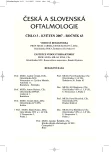Ocular Manifestations in Turner’s Syndrome
Authors:
R. Brunnerová 1; J. Lebl 2; J. Krásný 1; Průhová; Š. 2
Authors‘ workplace:
Oční klinika FNKV a 3. LF UK, Praha
přednosta prof. MUDr. P. Kuchynka, CSc.
1; Klinika dětí a dorostu FNKV a 3. LF UK, Praha
přednosta prof. MUDr. J. Lebl, CSc.
2
Published in:
Čes. a slov. Oftal., 63, 2007, No. 3, p. 176-184
Overview
Turner’s syndrome belongs to the most common chromosomal aberrations. It is caused by the deficiency or structural anomaly of one X chromosome, possibly by chromosomal mosaic. In this syndrome, some ocular diseases are more common. During the seven years period, we repeatedly examined 81 girls and women with Turner’s syndrome; the range of age was 7-26 years. We observed the eye diseases appearance and their possible association with the karyotype. In these girls, the most common is myopia (29 %), item hyperopia (24 %), epicanthus (20 %), color vision disturbances (17 %), amblyopia (12 %), strabismus (10 %) and ptosis (5 %). The color vision disturbances were defined as protanopia in 8.5 %, deuteranopia in 3.4 % a tritanopia in 5.2 %. The occurrence of strabismus and ptosis were higher than in the average population. The total incidence of refractive errors was slightly higher than in normal population, with different incidence according to the karyotype. Hyperopia was found more often in karyotype 45, X (28 %), whereas in chromosomal mosaic in 18 % only. Inverse proportion was in myopia – in chromosomal mosaic was found in 31 % and in karyotype 45, X in 26 %. Generally, while comparing the incidence of separate ocular diseases in karyotype 45, X and in chromosomal mosaic, the findings were similar.
Key words:
Turner’s syndrome, karyotype 45, X, chromosomal mosaic, refractive errors, color vision
Labels
OphthalmologyArticle was published in
Czech and Slovak Ophthalmology

2007 Issue 3
Most read in this issue
- Ocular Manifestations in Turner’s Syndrome
- The Methods of Analysis of the Endothelial Microscopy
- Comparison of the Two Methods, LASIK and ICL in Mild and High Hyperopia Correction – Part One
- The Contribution of the Hematological Examination in Patients with Retinal Vein Occlusio
